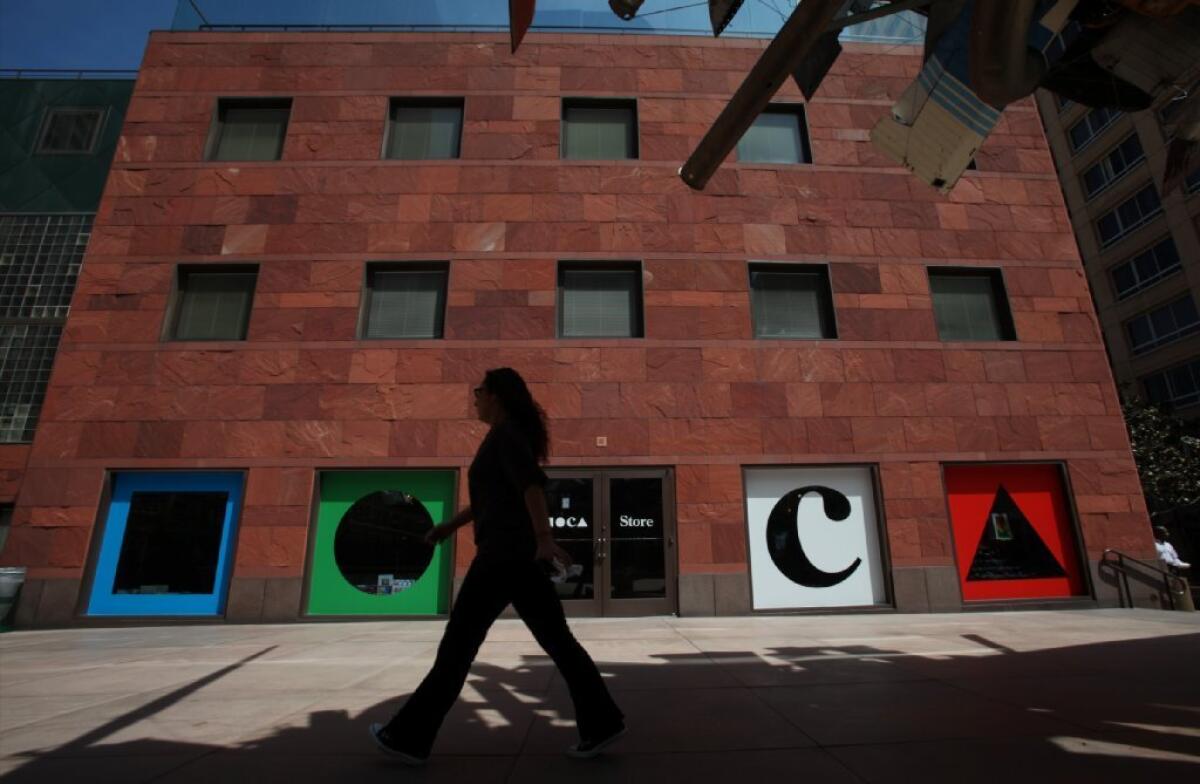Newsletter: Essential Arts | MOCA and the Marciano show two ways to handle a museum union drive

Aaaand we’re back, with a co-production brought to you by arts and entertainment editor Laurie Ochoa and staff writer Carolina A. Miranda, featuring all of the week’s essential arts news — along with expensive bananas.
One union, two museums
We’ll start with Carolina Miranda‘s report on MOCA: Over the last month, workers at two L.A. museums have announced union drives: the Marciano Art Foundation and the Museum of Contemporary Art, Los Angeles. The journey ended very differently at each site. On Friday afternoon, the Marciano sent out a statement that it would close permanently, while MOCA announced that it would voluntarily recognize the new union. “We’re taking this step to come together as one team, one MOCA,” said the museum’s director Klaus Biesenbach.

Laurie Ochoa takes it from here, with roundups on music, art, dance and theater:
The power of music
One of the most emotional moments in Noah Baumbach’s “Marriage Story” comes courtesy of musical theater icon Stephen Sondheim when Adam Driver, as one half of the divorcing couple at the heart of the story, turns to song to tell friends about his breakup experience. “Of all the show tunes in musical theater history,” writes Times reporter Ashley Lee, “he sings ‘Being Alive’ — a choice that, as most Broadway fans will catch, actually makes the Netflix movie even more layered, profound and heartbreaking.” (Bonus: Lee cites the great former Times theater critic Dan Sullivan.)
Times contributor Tim Greiving talks with composer Randy Newman about his score for “Toy Story 4” — and how, “after years of being ignored by directors of live-action dramas, this year he brought his nostalgic pathos to Baumbach’s ‘Marriage Story.’” Newman told Greiving: “Both the pictures I did sort of tug at the heartstrings.”
Speaking of Newman, his “I Love L.A.” has long been the first title people bring up when they talk about songs about Los Angeles. But in a months-long project, Times music writer Randall Roberts analyzed hundreds of songs about our city to come up with 50 Songs for a New L.A., music that maps Los Angeles for a new generation. And because we don’t want to forget our roots, Roberts also put together a list of 25 sure-fire L.A. classics.
In the galleries
A shoe, a love letter, multiple combs and hair brushes arranged on a backdrop. We’ve seen a cataloging of such items before in Holocaust museums, but now the confiscated items are being trashed at the U.S.-Mexico border. Photographer Tom Kiefer worked as a janitor at a U.S. Customs and Border Protection facility in Arizona for more than a decade, secretly collecting immigrant belongings and taking pictures. As Times reporter Makeda Easter writes, many of the images are on view in the exhibition “El Sueño Americano | The American Dream: Photographs by Tom Kiefer” at the Skirball Cultural Center.
Times art critic Christopher Knight took in the more than 200 largely black-and-white photographs and videos by artist Shirin Neshat at the Broad. He found power in the neutral palette. “Her photographs, mostly portraits, are formal, sober and considered, contrary to the topical flow of most photojournalism,” he writes. “The image of Iran that an American carries in his mind is almost exclusively crafted by mass-culture pictures. Neshat’s say: Reconsider.”
Leah Ollman wrote about the first L.A. show from Paris artist Tatiana Trouvé, whose staged “architectural interventions” are at Gagosian in Beverly Hills through Jan. 11.
Times contributing reviewer David Pagel also made the gallery rounds: “No people appear in Peter Holzhauer’s 16 photographs at Gallery Luisotti, but you feel as if you’re looking at portraits,” he wrote of the artist’s landscape images of Iceland. Of the new Gilbert & George show, Pagel says, they “transform Sprüth Magers gallery into a giddy, head-spinning extravaganza.”
As the owner of a couple of Laura Owens books (she was a favorite of my late husband, Jonathan Gold), I was especially interested to see that the artist’s new show at Matthew Marks Gallery is devoted to handmade books and the custom-made tables on which they rest. “Her quiet, bookstore-style installation,” Pagel writes of “Books and Tables,” “turns its back on the eye-grabbing dynamics of social media — and the heavyweight expectations of mural-scaled paintings — to make room for experiences that unfold slowly and subtly, gently and freely.”
On the stage
People were outraged when choreographer Matthew Bourne put male swans in a 1995 production of “Swan Lake.” But as Lewis Segal writes, “what had been a shocking sideshow in 20th century dance is now a kind of mainstream monument.” Is the production — which just landed at the Ahmanson — still relevant? Segal points out that “given our culture’s evolved discussions about portrayals of women, you could argue that the treatment of the prince’s mother and girlfriend should be more nuanced and sympathetic.” Yet Segal finds Bourne’s staging “still gloriously pertinent and impertinent,” and a work that continues to “speak to the homophobic violence that still exists almost everywhere.”
Another alternative casting decision — this time over the series of black actresses playing Hermione Granger in “Harry Potter and the Cursed Child” — is leading some observers to ask: “Has blackwashing become the new whitewashing?” Many are thrilled that Yanna McIntosh, at the Curran theater in San Francisco, is about to become the eighth black actress to play Hermione since the play’s first staging in 2016. But as contributor Erika Milvy writes: “Critics worry this presto-chango switcheroo is a mere bandage that masks the persistent lack of authentically diverse characters and stories making it to stage and screen.”
Composer Lei Liang was named the 2020 winner of the Grawemeyer Award for Music Composition, “sometimes referred to as the Nobel Prize for music,” as San Diego Union-Tribune pop music critic George Varga reports.
On the stage 2.0
And now the newsletter baton goes back to Carolina, bringing you news from the stage, as well as the weekly news roundup and novel-reading pitbulls:
Ashley Lee reports on the new “Frozen” song you can find only on stage — a duet between sisters Elsa and Anna. Co-composer Kristin Anderson-Lopez says they “had been itching to write the sisters a song like this. It was like a spare firework, and all we had to do was light it.”
Cellist Sheku Kanneh-Mason was all set to make his L.A. debut when he got called away for a last-minute gig: Meghan Markle‘s wedding to Prince Harry. He finally made it back for a performance at the Colburn School, a co-presentation with the Los Angeles Chamber Orchestra. He chats with contributor Tom Jacobs.

Ready for the weekend
Matthew Cooper picks the best of the week ahead in dance and art, and he rounds up the 10 best things to do in L.A. right now, including the ongoing production of “Frozen” at the Hollywood Pantages.
ICYMI
Our newsletter was dark over the holidays, but I wanted to highlight some great pieces that appeared while everyone was stuck at an airport or on the 405. These includes a review of Nayland Blake‘s solo show at the ICA LA, which exudes a “mordant humor of layered depth,” by Times art critic Christopher Knight; a look at how the Monday Evening Concerts series at Zipper Hall remains full of surprises by Times classical music critic Mark Swed; and a great profile of “Slave Play” playwright Jeremy O. Harris by Times theater critic Charles McNulty.
And because I have the keyboards — bwahahaha — I’ll add to the pile the bit I wrote about a pair of very striking shows at MASS MoCA by Rafa Esparza and Marcos Ramirez, who is known as ERRE.
Your support helps us deliver the news on culture — and this newsletter. Subscribe to the Los Angeles Times.
In other news...
— The story of the $120,000 banana is the story of Art Basel Miami Beach.
— For a profile in the New Yorker, Beck takes a tour of LACMA.
— Rather than giving the prize to a single artist, Britain’s Turner Prize has been awarded to all four finalists after they asked to be treated as a collective.
— The Dialogues podcast has an interesting interview with curator Flavin Judd and poet Eileen Myles.
— Stephen Garrett, the architect who helped J. Paul Getty build the Roman-style Getty Villa and would later serve as the museum’s first director, has died at the age of 96.
— The Broadway-bound musical “The Devil Wears Prada” has announced casting.
— SF Opera’s Eun Sun Kim has become the first Asian woman to lead an American opera company.
— Composer on composer: I enjoyed this essay that John Adams wrote about Pierre Boulez.
And last but not least...
While I was on vacation, I dug into Valeria Luiselli’s latest novel “Lost Children Archive,” which pits a failing marriage against a backdrop of political crisis — namely, the child detention crisis at the border. “They call them the ‘lost children,’” Luiselli writes. “I suppose the word “refugee” is more precise ... in a way, I guess they are lost children. They are children who have lost the right to a childhood.” The book is poignant and exquisite.
Pairs well with this essay Luiselli wrote on Wild West reenactments in Tombstone, Az.

More to Read
The biggest entertainment stories
Get our big stories about Hollywood, film, television, music, arts, culture and more right in your inbox as soon as they publish.
You may occasionally receive promotional content from the Los Angeles Times.








